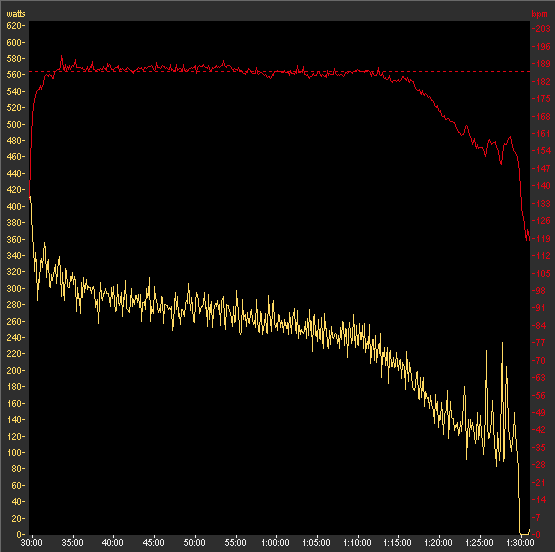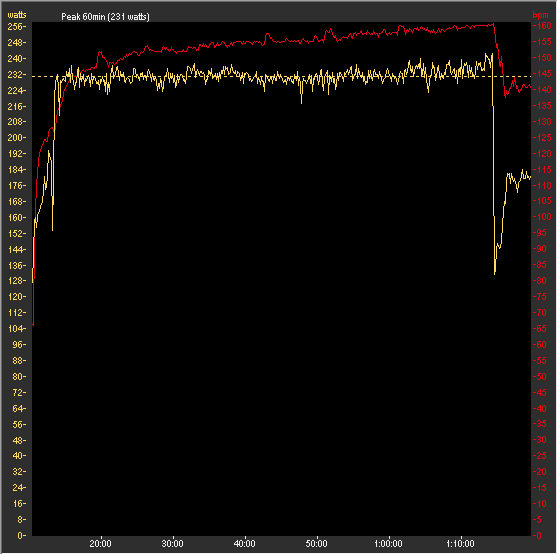what heart rate
mikeh202
Posts: 45
Just wonering what heart rate as a % of max you are all able to hold on a 10 mile tt
0
Comments
-
not that I use HR anymore but I wouldn't hold a HR for a 10 anyway, it would be creeping ever higher through the event. A flat HR line for a TT like that is an indicator that pacing wasn't good.
on average, I suppose it's somewhere ~ 90% give or take.0 -
I am normally 90%+, though that is based on the 220-age calculation which I know is wrong for me, so it might more in line with the 90% as Alex has said above.
I don't really look at it on a 10m TT, only glance occasionally on 25m TT's.0 -
On a 10 i am trying these days to include a pacing strategy, last season when I decided to add a few 10's to my RR diet, I used to just go as hard as I could from start to finish.
No i try and hold myself back a little bit for the first 2 - 3 mins and then hit it a bit harder.
In answer to the question - I find that from the point where I try and turn it up a bit to the finish i am usually around 90 - 93% of my HRM.0 -
No idea. I never wear a HRM when I ride a TT. It would raise more questions than it answered and just be a distraction.
Ruth0 -
Alex_Simmons/RST wrote:not that I use HR anymore but I wouldn't hold a HR for a 10 anyway, it would be creeping ever higher through the event. A flat HR line for a TT like that is an indicator that pacing wasn't good.
I've not done a 10TT, but I've run a lot of races of a time, and they're always essentially flat, just above "Zone 4", there's no steady increase/drift it shoots up to threshold and holds there, very steady. I'm not sure why it would be different on a bike, could you explain it?Jibbering Sports Stuff: http://jibbering.com/sports/0 -
I've had my HRM on for my first 4 TTs this season. Don't use it for pacing, more out of curiosity. Each time average has been around 90%. Don't know if that proves anything or not - i certainly don't feel i could have tried any harder!
Rich0 -
Cardiac drift. Common when riding at near threshold and above intensity levels.jibberjim wrote:Alex_Simmons/RST wrote:not that I use HR anymore but I wouldn't hold a HR for a 10 anyway, it would be creeping ever higher through the event. A flat HR line for a TT like that is an indicator that pacing wasn't good.
I've not done a 10TT, but I've run a lot of races of a time, and they're always essentially flat, just above "Zone 4", there's no steady increase/drift it shoots up to threshold and holds there, very steady. I'm not sure why it would be different on a bike, could you explain it?
Here's one reference:
http://physiotherapy.curtin.edu.au/reso ... toring.cfm
It's a few years old and probably written before power meters were common.
Here's an example of poor pacing, with HR going high early and then being held steady until the rider cracked. See how power falls continuously through the effort (this was an attempt to break the world age group hour record).
Here is an example of what happens through a TT like effort where power is held steady - you can see how HR continually drifts higher.
In a TT, if it's flat (say), then the fastest time will be achieved if the power is maintained at the highest sustainable level you are capable of for the duration.
If the power varies somewhat through the effort (even if the average is the same), then that ends up with a slower time due to the physics of bike riding (the relationship between speed and power is a cubic one). A little extra speed requires a lot of extra watts so you lose overall compared to an isopower strategy.
However if the power varies somewhat, then maintaining the same average power as an isopower effort is generally not posible due to the physiology of the human body (our responses to intensity are not linear but are curvlinear). A little over threshold is way way harder than a little under.
IOW in a flat TT, varying the effort, i.e. power, (even though HR might give the false impression of a constant effort) is sub-optimal from both a physics and physiological standpoint. And probably more importantly, that also how it works in the real world of TT riding.
So, in a TT level effort, if I see a HR line that gets up fast and then stays steady, it is typical for that to be accompanied with a gradual decline in power output through the event, and that is a sub-optimal pacing strategy.
It gets a bit more complicated when you analyse variable terrain* (where variable effort is optimal) but the principles remain the same.
* which I have done extensively0 -
I always record HR's, tend not to look at them during a '10' but will watch them during longer races to make sure I don't overcook it.
My best effort for a '10' averaged 93% of Max HR and finshed at 98%.
For a '25' the ave was 91%, and max 97%
For a '50', 90% ave and 93% max
For a '100', 83% ave and 90% max
But I once rode my socks off doing a solo effort in a road-race and averaged 93% for 90mins with a max of 98% at the finish.0 -
Alex_Simmons/RST wrote:Cardiac drift. Common when riding at near threshold and above intensity levels.
Thanks.
I'm coming at this from a background of running, where I have more experience, but the pacing strategies are essentially the same, maintaining even power output for the duration (as you point out in flat TT's) In 5km and 10km events, Cardiac drift is rarely seen, it's only in the longer events once the activity gets over the hour.
Which is what surprises me to say that cardiac drift is required for optimal pacing. I'm not even completely confident that your increasing heart rate shown in the graph can be accounted for simply by Cardiac drift, and not by other factors actually requiring the rider to increase their work to maintain power (recruiting more muscle as fatigue increases etc.)
(In the graph which shows the bad pacing, isn't it a 90 minute effort, so not the hour record?)Jibbering Sports Stuff: http://jibbering.com/sports/0

